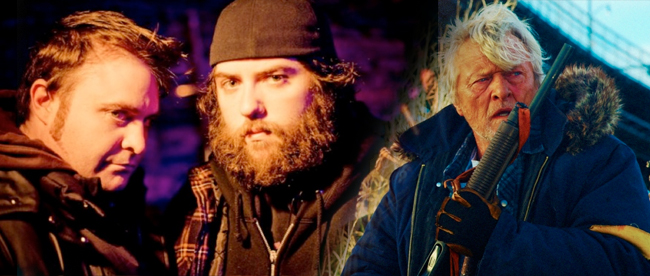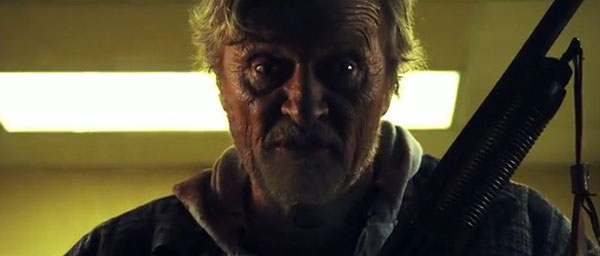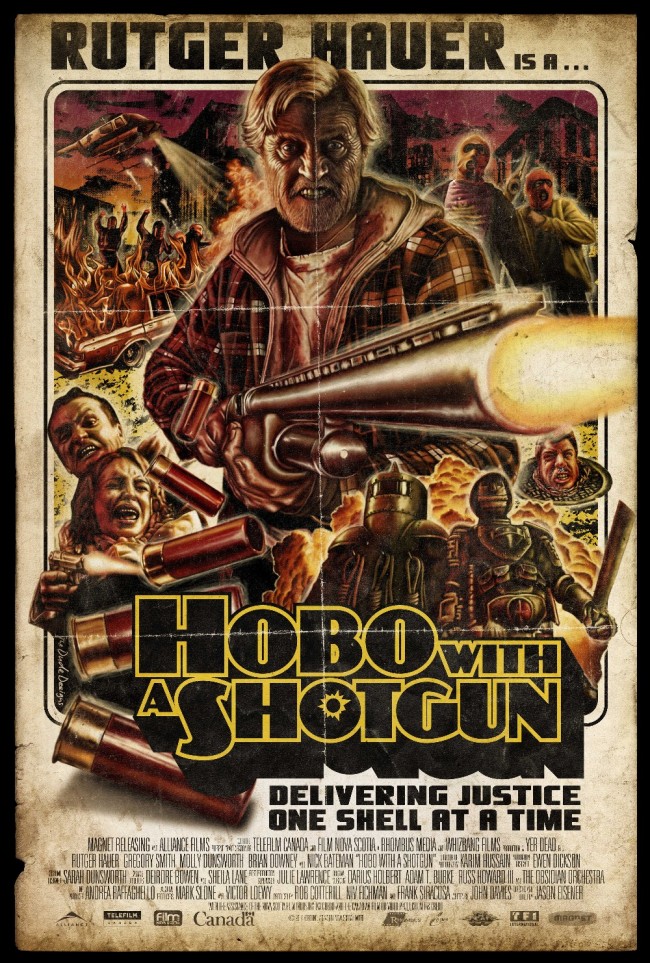
In the midst of SXSW, Hobo with a Shotgun writer/director Jason Eisener and producer Rob Cotterill made some time to sit down with TFS for a few minutes and discuss the film. Check it out below and see Hobo With a Shotgun on VOD today.
TFS: I talked to you on Twitter about a month ago and you had said you had tried to get professional wrestler Jake “The Snake” Roberts for a part in Hobo with a Shotgun. What part were you thinking for him and why didn’t it end up working out?
JE: Jake “The Snake” Roberts is one of my favorite wrestlers of all-time; I think he’s probably one of the best actor-wrestlers of all-time. He wasn’t a crazy physical guy, but he could control an audience just by his presence. And I was thinking “that’s a lot of who The Drake [the main villain of Hobo with a Shotgun] is; he can command an audience and spread fear.” He was my first thought when it came to The Drake, but while we were in the middle of trying to get him, we got an audition from Brian Downey and it was just so fuckin’ awesome that we just kind of forgot about Jake. I don’t know maybe later down the road we can get the chance to work with him.
Hobo with a Shotgun, as many people know, began as a fake trailer for a contest at SXSW back in 2007. Did you always have a feature in mind?
JE: We heard about the contest, we got together immediately that day and we basically wrote a treatment as to what the whole idea would be about and we’d pick our moments of what we’d wanna use for the trailer. We thought it might make a cool short film at first, but when we saw the reaction of the people online and they were demanding we make a feature film, we were like “fuck, why don’t we just go out and shoot it with our friends?” It wasn’t until we got a call from Alliance, our Canadian distributor, and they wanted to fly us up to Toronto to talk about the idea of making it a feature film. We met a producer named Niv Fitchman who got behind us and supported us to make the film.
It didn’t take long to bang out the first draft of the script, but it’s become a completely different beast. We wrote like 27 different drafts of the script, so it became something different than it was originally intended to be. It’s such an easy thing making something called Hobo with a Shotgun; anyone could come up with their own ideas for a movie with that title.

How did you get Rutger Hauer to star in Hobo with a Shotgun?
JE: Alliance told us to make a list of the top five actors we’d like to have to play the main role; just go off and list our dream people. And growing up, Rutger Hauer was my favorite actor. The movie is very much a Western and I wanted to bring that class and style of a Western character, and Rutger was all class and style. He just felt natural, and he was unanimously the number one pick. It just felt cool to write his name down, and thinking “there’s no way in hell we’re never going to get him.” But it’s going to get people an idea as to the kind of person we wanted to try and get. Then a couple days, they got the script to his agent and the next thing I knew I was having a Skype conversation with him. We hit it off and next thing we knew, he was in Halifax with us making the film.
What were your influences on creating the look of Hobo with a Shotgun? It’s a very gritty, grungy film.
JE: It comes from a lot of our influences, from exploitation movies of the past. Movies like Street Trash, The Warriors, Dead End Drive-In, Savage Streets, those were all pretty huge influences. I just love those worlds; The Warriors is my favorite movie of all-time. I just love those crazy high-concept worlds.
RC: Especially those worlds that create their environment on the street.
Where did the look and concept of The Plague come from?
JE: That comes from the 80’s and growing up on high-concept cartoons and movies as well as wrestling. The Plague, I feel, are two characters that could have stepped right out of He-Man and The Masters of the Universe. It was my opportunity to create what I thought could be two of the coolest action figures. The characters have been kicking around our head for quite some time; one of them is in one of our earlier films. They are kind of like our C3PO and R2D2 or our Jay and Silent Bob, hopefully you’ll see them pop up in other movies. There’s a whole mythology behind them. They’re basically like demons; for me, there’s nothing beneath their costumes. To me, they’ve been around since the beginning of time, probably had tons of other crazy armor, riding on horses, etc. You see in their lair they have a bunch of bounties crossed off and one of them’s Jesus Christ, another is Joan of Arc.
We’ve written a treatment for a movie about The Plague. It’s like a crazy chase film; it’s about two ambulance drivers who has an unconscious person in the back of their ambulance who they don’t know is a bounty for The Plague. The Plague are doing everything to stop the ambulance and the ambulance drivers using everything they can to stop The Plague. It also goes a little into their history and how they started and what they’ve been through.
You chose to premiere the movie at Sundance as opposed to SXSW where the trailer had first premiered back in 2007. Was there any ill will from anyone for that?
RC: Not at all; the movie was just done. Treevenge, our first movie, had played at Sundance and we just took advantage of sending it to a festival that we thought would take it. We were fortunate to get it into Sundance, which was just crazy.
JE: Especially for the kind of movie that it is.
RC: Sundance embraced us as well as SXSW and SXSW wanted to have the movie as well and we were fortunate enough to do both. The dream U.S. festivals.

How were the audiences at Sundance? It seems like it’d be more of a buttoned-down crowd.
JE: I thought it’d be too going into it, but no man. Everyone’s cool there.
The exploitation genre has been making a comeback since Grindhouse came out back in 2007. Do you think they have a place in the current state of cinema?
RC: They totally do. I think what they bring to cinema is the freedom to have fresh and new ideas and high concepts. High concepts that more mainstream studios will stay away from. I think people are hungry for new shit.
JE: Especially today. I consider Hobo to be a new exploitation movie; I consider it almost to be like a YouTube movie. It’s for a new audience that can process information so quickly; I want people to leave the movie and were attacked by so many high-concept ideas and crazy ideas. There’s definitely an audience out there, especially with how easily things can get quickly passed around out there with the Internet. We tried to make Hobo in a way that every scene in the movie could be its own viral video if any of it leaked onto the Internet. It was very important to keep the narrative, the story, and the characters strong through that circus as well.
Admittedly, I expected Hobo with a Shotgun to be a crazy and funny exploitation movie, but it also felt like it had a darker side to it that many people may not think of it having when they go to watch it. Is there something deeper going on in the movie that others may not expect?
JE: Oh definitely; there’s a ton of social commentary hidden beneath for people to find.
RC: And that goes with our goal of keeping the movie grounded and straight; we kept that darkness in the movie and in the story that it’s telling. It’s about these two people that are the scum of the Earth as far as society is concerned that show the city that has no respect for them that things are worth fighting for. That’s where I think the darkness comes through too; despite all the absurdity and humor, there is a message in that movie. I think people are grasping onto that as more see it.
Hobo with a Shotgun is heavy on practical effects. Were there any shots or effects that were harder to pull off successfully than others?
JE: It seems like the simplest one in the movie, but the part where the doctor gets impaled by the sword through the pack.
RC: I don’t want to talk about it. [laughs]
JE: Rob was in charge of that; he was doing second unit and it probably took thirty takes.
RC: More. We tried it on three different occasions during the shoot; we tried it on the day we actually shot the whole scene and then we tried it on two different days when we were doing other second unit work. The rig wasn’t working at all and it hadn’t had its stuff ironed out. We shot over 40 different times. It takes so long to reset because the shirt’s all bloody, we wanted to get the insert and the exit, and we were using this dummy…it was an insane rig that took a bunch of people to make the dummy move and to pull it off. Ultimately, which is really annoying to me, we used one of the takes we did on the very first night [laughs]. Me and Jason share the same anality of getting things just right; maybe we get it the first time, but we keep trying to see if we can do it better.
For me, another one of the effects rigs that was really painful was the skate in the chest. That rig absolutely failed; there was some pressure problems with the hosing and the skating rig wasn’t doing what we wanted it to do and all sorts of problems like that.
Despite the difficulties, do you still prefer doing practical effects over using CGI to do everything?
JE: Oh yeah, yeah, yeah. I can’t stand CG gore effects or blood; every time I see it it just takes me out of the movie and it just looks cheap. I want to see heart and soul put into effects, and I find digital effects can be kind of soulless because you know it’s just done by a bunch of people behind computers plugging it in. There is a whole art to CG that I do appreciate, don’t get me wrong, but when it comes down to gore and blood effects…if you prepare it properly, you can do it on set. Even if it looks like it was done for ten dollars, it’s just more fun to watch.
RC: It feels better and keeps you in the movie. I respect CG as a way to enhance things, not as a way to get out of something. I found a lot of films use CG to solve a problem. Filmmaking for me, and especially for the films that inspired us, is the thoughts of “how are we gonna make this work?” and that’s part of the fun and part of being grounded in the film world. Like Jay said, it just takes me out; I have yet to see a CG blood or gore effect that looks realistic. I’d rather see a cheap gore gag instead of a CG effect that just looks fake. I’d rather see real fake [laughs].
JE: There actually is CG in Hobo, we just did it in a way that people wouldn’t notice.
I could not tell there was any CG in Hobo with a Shotgun, what were some of the places you used it?
JE: The shot of the city in the beginning, we fucked it all up and made it look burned out. All the harpoons in the hospital scene were CG’ed. The Plague hideout was also CG’ed in.
RC: We used it in a real subtle and not dependent way. We could have used inserts of the gun going off and just spliced it into the movie and no one would have known it wasn’t in the shot, but it helped the movie to do it this way.
Do you want to stick with the exploitation genre, or are you hoping to branch out sometime?
JE: We definitely want to branch out, but right now, we’re loving it. We’re going to stay with high-concept ideas; I’d like to make a kids movie like Monster Squad or The Goonies, or something like Night of the Creeps. I’d love to do something like that. Our next film is going to be a martial arts movie, but in the world of Hobo with a Shotgun pretty much. We want to branch into different genres, but we’ll stick with high-concept ideas.
For your next film, the martial arts movie, any ideas on the plot or what influences you’ll be pulling from?
JE: Our influences movie-wise are Class of 1984, The Wanderers, Bloodsport, Ricki-Oh, and maybe a little bit of Rock and Roll High School. Like I said, it’s a high school martial arts fight movie that’s kind of in the world of Hobo; it’s the worst high school you could imagine.

Have you written a script or anything for it yet?
JE: We’ve written a treatment, and we’re in the beginning stages of starting the first draft of the script. It’s hard to find time to sit down and really write it right now with everything that’s going on.
You’ve been running your own fake trailer contest on your website. Why did you decide to do this?
JE: Basically when SXSW put on the contest for Grindhouse, it opened the door for us to make something and get it out there.
RC: It helped us get into a community with a zillion other indie filmmakers who also made those trailers and were watching these trailers. That was a huge step for us; it really created this community of young filmmakers. We still talk to a lot of them today. We just wanted to give back and keep that tradition going; give someone else the opportunity.
JE: Give them the opportunity to make something that could get attention and maybe grab an audience. We’re just trying to open the door for other filmmakers to have the opportunity we had.
Hearing what you have been working on, it sounds like they all take place in the same sort of world. Are you going to base all your movies in the same universe?
JE: Maybe. I think we know what our world is, and I think it’s probably going to. It depends on the project, but we definitely want to make more movies in the world of Hobo with a Shotgun. That’s a world where anything can happen. It’s not really present day or even planet Earth; it’s like its own dimension.
There is an 8 bit Hobo with a Shotgun game that got released earlier this year on the IOS platform to coincide with the movie’s release. Would you want to make more games, like maybe something on the PS3?
JE: Oh yeah. At some point, I’d love to help out with video games that would be a dream come true. I’ve designed our next movie as if I was creating my own tournament game like Mortal Kombat or Street Fighter 2. I’m designing every character to be unique both in look and fighting style so if we ever made a game, it’d be the coolest tournament fight game ever. I would absolutely love to dive more into that world.
That’s cool that you think in more than one medium with your projects. Could we see like a Hobo with a Shotgun prequel or another story involving the Hobo, like in comic book form?
RC: For sure. There are a thousand tales of the Hobo to be told.
JE: To me, I’d love to make my Western trilogy out of Hobo; Rutger refers to it as a “graffiti Western” and I’d love to take it into doing the full trilogy. We’ve done little subtle things that could help support the idea of being another film. If the opportunity comes up, I am on it, I’m ready to do it.
Hobo with a Shotgun hits Video on Demand April 1st and will get a limited theatrical run starting May 6th. For more information on the movie, visit the official site.
